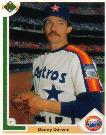

Derek Lowe posted a 3.61 ERA in 222 innings last year, yet hardly anyone noticed. Is this because he A) posted a 4.62 ERA between May and July B) was on a Dodgers team that went below .400 after their 12-2 start C) only compiled a 12-15 record on the season or D) was still overpaid despite that quality season?
I don’t have the answer, naturally, since I am one of the few who noticed. I am also one of an even more select group who predicted that Lowe would lead the NL with 24 wins and win the Cy Young Award for 2006. Why am I so high on Lowe? Glad you asked.
Splitsville, Baby
Statisticians will tell you that there’s no evidence of players in baseball showing a consistent tendency to succeed more during the first or second half of the season. To them, I say, “Johan Santana.” But whether you agree with them or not, you might have to admit that pitchers with good second half numbers probably figured something out during the season. Whether they were tipping off pitches, missing their release point, or simply trying for too many strikeouts, odds are that if a pitcher struggles at the beginning of the season and fixes it midseason, that he will make it a point to carry that adjustment into the next year.
At this point, let’s review Lowe’s 2005 splits:
|
|
W-L |
IP |
H |
R/ER |
HR |
K |
BB |
ERA |
AVG |
|
Pre-AS |
5-9 |
119.2 |
134 |
69/53 |
15 |
81 |
28 |
3.99 |
.280 |
|
Post-AS |
7-6 |
102.1 |
89 |
44/36 |
13 |
65 |
27 |
3.17 |
.235 |
 | |
| Webb and Lowe stick to keeping it low |
Groundball pitchers give up more hits than flyball pitchers do, but they’re less costly ones. According to THT 2006, 6.1% of outfield flies go for doubles, while only 1.9% of grounders do (makes you think twice about guarding the lines, doesn’t it?). 11% of outfield flies go for homers, whereas grounders did not even produce an inside-the-park homerun between 2002 and 2005. The double play factor should be fairly obvious as well.
Point being, the average run value of an outfield fly is .035, but -1.10 for a ground ball and -.287 for a strikeout. Obviously, a K is a better result for a pitcher than a ground ball is. But when you’re inducing twice as many ground balls as the average pitcher, you can make ground balls into a defensive weapon. Derek Lowe makes for a legendary groundball pitcher, but just a mediocre strikeout man. As long as his K/BB ratio remains near his 2.4 mark of the second half of ’05, concentrating on inducing grounders should be the way to go for Lowe.
Defense (clap-clap!)
Defense (clap-clap!)
There’s a reason that Neddie Colleti broke the bank with
Rafael Furcal. That reason begins with a
D and ends with a Lowe. My trusty Fielding Bible shows
Adam Everett to lead all shortstops with +33 plays last year, but Furcal was
not far behind at +26. Also, Furcal was
able to turn a DP in 64% of his opportunities, while
His new double playmate, Jeff Kent, is not considered a good
second baseman. That’s probably because
he has the reaction time of a drunk horse.
In fact, you can put much of the blame for Izturis and Robles’ poor DP
ratios squarely on
 | |
| Kent: Less ground to cover? |
That’s right. For those who missed it, Nomar Garciapara, the Dodgers' new first baseman, was not a terrible defensive shortstop, even in recent seasons. His 3-year Plus/Minus as a shortstop was -1. I’m betting if he has enough range to play shortstop that he’ll have surplus range over at first base.
On the other side of the diamond, you have reliable old Bill Mueller with a +6 last season, where five Dodgers combined for +4 last year. All in all, the infield is much improved defensively, and will be even more so when Izturis returns form injury to spell Kent at second every now and then (say, every time Lowe starts?). Izturis may only have average range and arm for a shortstop, but those skills would be a plus as a second baseman. See Craig Counsell for an example of how that works.
Run Support
The Dodgers only scored more than four runs in 15 of Lowe’s 35 starts last year, and one of those was five runs in a Coors Field loss. This year’s squad should not only score a lot more than 685 runs in a division where quality non-Dodger pitching is scarce, but they should be able to put up runs on a more consistent basis with one of the game’s premier leadoff hitters now on the club. Furcal has scored triple-digit runs in each of the last three years, bringing the ability to score runs without a string of three consecutive hits or a dinger. Last year, Furcal was 46 of 56 in stolen bases, while the entire Dodgers team went 58 for 93.
He finished strong, has a defense tailor-made to fit his style of pitching, and a team behind him that should dent the scoreboard day in and day out. What’s not to like? Lowe for Cy Young in 2006! (24-7 2.69 139)
|
Become A Sponsor of BaseballEvolution.com Sponsor a page at BaseballEvolution.com. On a page of your choice, you can place a personalized message, a tribute to a player, or a link to your website! |
